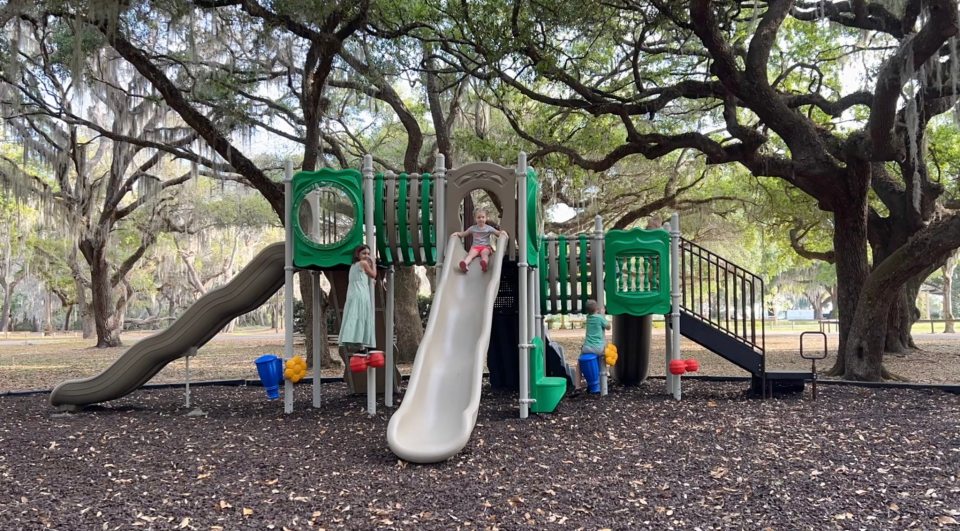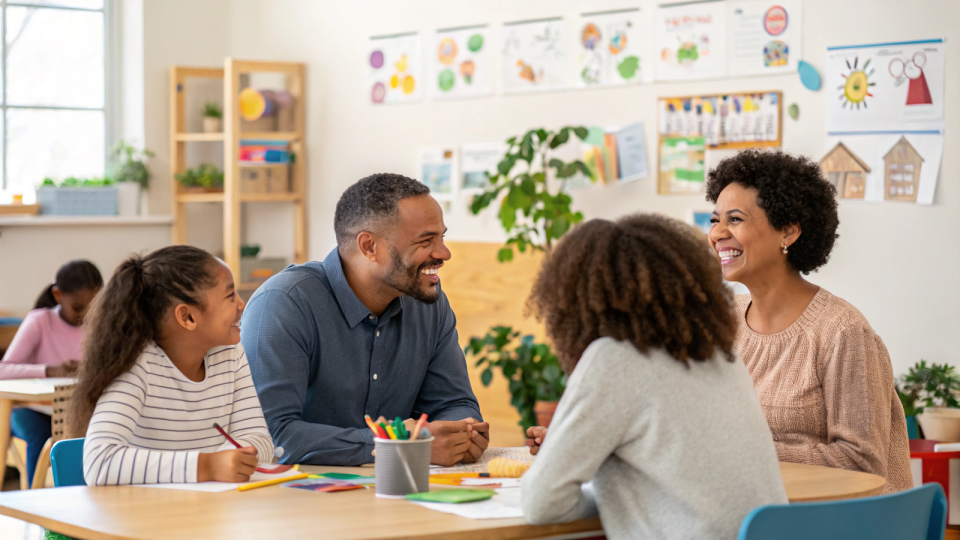Have you noticed how your child’s environment affects their focus, exploration, and learning? A well-designed learning space does more than hold a desk and a chair—it helps build curiosity, independence, and a lasting love of learning.
When kids can access inviting spaces with organized materials, flexible seating, and room for movement or creativity, they’re more likely to stay engaged and feel confident in their routines. These environments support learning habits that carry over to school and life.

1 – Creating an Inspiring Learning Space
A thoughtfully arranged learning space helps children stay curious, focused, and confident throughout their educational journey.
Encourage Movement and Play
Outdoor play areas support more than just physical activity—they also promote essential social growth.
Many studies highlight how play helps children build emotional awareness, communication skills, and confidence as they engage with others. For example, research by Davies (1996) revealed that 50% of the preschool teachers surveyed saw outdoor play spaces as especially valuable for children’s social development.
These open-ended environments allow children to practice interacting with peers and teachers in real time. Incorporating versatile school playground equipment for collaborative play can transform outdoor areas into dynamic learning zones that support physical activity, social development, and meaningful connection.
When children collaborate in play, they naturally learn to resolve conflicts, take turns, and express their thoughts—skills that support strong social-emotional development for school and life.
Bridge Learning Gaps with Tech Access
In a digital age, learning often extends beyond books and paper. Having access to a reliable refurbished laptop for student learning can open doors to educational platforms, research tools, and creative projects, helping students stay engaged and connected both inside and outside the classroom.
One of the most practical benefits of choosing refurbished tech is the significant cost savings—many models are available for 20–70% less than brand-new ones.
This affordable option allows families to equip their children with essential learning tools without compromising quality or stretching their budget. Whether writing an essay, joining a virtual class, or exploring STEM apps, the correct device can expand what’s possible at home.
Essentials for a Productive Learning Area
Before setting up your space, reflect on how your child learns best. Use these elements to support consistency, focus, and creativity:
- Clear, labeled storage for books and learning tools
- Flexible seating for writing, reading, or movement
- Natural lighting, whenever possible, to reduce eye strain
- Quiet zones for independent work and focus
- Display areas that celebrate effort and progress
A well-prepared environment supports not just academic skills but also daily routines. Its thoughtful design boosts your child’s independence while making learning a natural part of home life.
| Model healthy emotional expression: Adults should demonstrate appropriate ways to express and manage emotions, validating children’s feelings and showing constructive coping behaviors. |
2 – Adapting to Shifts in Learning Modalities
Over the past few years, learning has changed significantly, and so have the ways families support education at home. In 2022-23, 5.2% of K–12 students in the U.S. were learning from home, marking a noticeable increase.
Creating an adaptable home environment means considering how your child best learns through movement, conversation, visual input, or quiet reflection.
The goal is to support virtual learning when needed while allowing room for creativity, downtime, and real-world knowledge.
Every child has a unique way of processing and retaining information. Understanding your child’s preferred learning modality can help you shape spaces and routines that match how they engage best:
| Learning Style | How They Learn Best | Helpful Tools and Strategies |
| Visual Learners | Prefer to see concepts through images, maps, colors, and diagrams | Use charts, graphic organizers, color-coded notes, videos, and picture-based materials |
| Auditory Learners | Absorb information through listening and verbal discussions | Include audiobooks, music, storytelling, read-alouds, or verbal repetition |
| Kinesthetic Learners | Learn through movement, building, and doing | Set up hands-on activities like role-playing, experiments, and physical manipulatives |
| Tactile Learners | Understand ideas best through touch and object manipulation | Incorporate puzzles, arts and crafts, drawing, or textured learning tools |
Many children don’t fit neatly into one category—they benefit from multimodal learning, which blends different styles to build a more profound understanding. For example, a child might enjoy reading about a topic, then building a model to reinforce what they’ve learned.
Blending tactile, visual, and auditory tools in your home setup helps make learning more accessible during both structured lessons and unstructured exploration. This flexible approach supports smoother transitions throughout the day and helps your child stay engaged, no matter the format.
3 – Encouraging Emotional Well-being and Security
A strong emotional foundation helps children feel safe, confident, and ready to learn. When kids feel emotionally secure, they’re more willing to take risks, solve problems, and recover from setbacks.
Learning environments grounded in consistency, warmth, and trust make room for emotional growth as much as cognitive development.
“Children with higher emotional intelligence are better able to pay attention, are more engaged in school, have more positive relationships, and are more empathic.”
— Salovey & Mayer 1990 (naeyc.org
Here are a few ways to support your child’s emotional well-being through their learning environment:
- Predictable routines that help children feel grounded and reduce daily uncertainty
- Calm, quiet spaces where children can take breaks or manage strong feelings
- Encouragement that recognizes effort as much as achievement
- Creative materials that invite expression, problem-solving, and open-ended exploration
- Daily check-ins to help children name and process their emotions
Each child responds to learning environments differently. Responding with empathy and intentional structure creates meaningful emotional support.
This allows children to share ideas, face new challenges, and build lasting resilience. With this foundation in place, learning becomes safer, deeper, and more connected to who they are.
4 – Strengthening Family-School Partnerships

Strong family-school relationships directly support a child’s academic achievement and emotional well-being. In fact, 89% of parents report staying informed through school updates, highlighting how essential consistent communication is in modern parent-teacher dynamics.
These connections help parents stay engaged in their child’s progress and show kids that learning is a shared effort. Meaningful partnerships form when both educators and families work toward shared goals.
These daily habits can strengthen that relationship over time:
- Regular updates via phone calls, text messages, or emails
- Joint decision-making in academic planning
- Participation in school events and classroom activities
- Open conversations about both successes and challenges
- Team-based problem-solving when issues arise
When families and schools communicate openly, children experience consistent support in and out of the classroom. Parents who feel respected as partners are more likely to stay involved, which boosts learning outcomes and emotional stability.
5 – Promoting Social Growth and Inclusivity
Children thrive socially in environments that encourage meaningful interaction and shared experiences. Inclusive learning spaces that support cooperation, empathy, and self-expression help children build friendships, understand diverse perspectives, and feel a sense of belonging.
Encourage Cooperative Learning
Children learn vital communication and problem-solving skills when working in groups toward common goals. Well-planned group activities promote both teamwork and flexibility across different ability levels. These moments help children practice compromise, listen actively, and recognize others’ ideas.
Build Supportive Social Structures
Simple, thoughtful adjustments can support positive interaction even during unstructured time. The physical layout of a space—inviting seating, shared materials, and zones for collaboration—can naturally support conversation and mutual respect.
To encourage social growth in everyday routines, consider these proven approaches:
- Create collaborative stations where kids can solve problems or complete tasks together
- Plan group activities that highlight the unique strengths of mixed-ability learners
- Offer quiet zones for children who may need breaks from group interaction
- Rotate groupings often to expose children to new social connections
- Use clear schedules and consistent communication tools to support every learning style
While structured activities are helpful, giving children space for spontaneous interaction is just as important. Open—ended play and flexible seating invite organic conversation and peer connection.
The goal is to provide consistent social support while letting each child develop independently.
| Build resilience through positive experiences: Help children develop problem-solving skills, impulse control, and a positive outlook by affirming their emotions, identifying positive situations, and encouraging imaginative play. |
6 – Tailoring Learning to Individual Development
Children grow in different ways and at various paces. A learning space that reflects your child’s developmental stage can boost focus, curiosity, and confidence. When learning activities match their current abilities and interests, children are more likely to stay engaged and make steady progress.
Each child’s learning journey is unique, so a one-size-fits-all approach doesn’t work. Building flexibility into your home setup can help you meet your child exactly where they are.
Here are the key components to include in a development-friendly space:
- Age-appropriate materials that challenge without causing frustration
- Adjustable areas that support different learning styles and energy levels
- Frequent activity changes based on your child’s shifting interests
- Organized zones that make it easier for your child to find, use, and put away materials
- Calm spaces for reading, quiet work, or downtime
Pay attention to how your child uses the space. Notice what captures their interest, where they hesitate, and what they repeatedly return to. These patterns offer practical cues on adjusting layout, rotating materials, or introducing new challenges.
Making small changes based on daily observations can keep the learning environment effective, manageable, and genuinely responsive to your child’s growth.
Learning Spaces That Support Growth and Confidence
Supporting your child’s learning starts with a space where they feel safe, focused, and ready to explore. A balanced setup—emotionally and physically—helps children stay curious and confident as they learn.
Flexible environments tailored to their needs build lasting skills like independence, focus, and resilience.
Small changes, like adding a quiet corner or rotating materials, can lead to considerable growth over time. Every update you make today helps shape your child’s learning tomorrow.
comments +